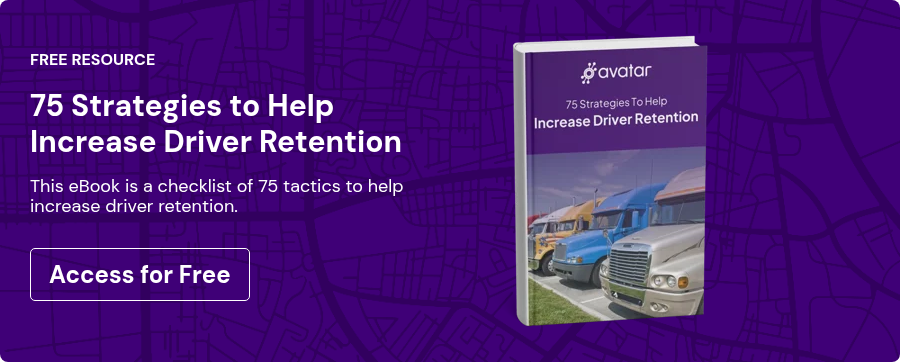How the Trucking Industry’s Turnover Rate Impacts Safety
Scott Rea
April 4, 2017
This blog post was updated on March 3, 2021.
Did you know your high turnover could be causing your accident rates to rise?
Vigillo LLC, conducted a study that concluded higher driver turnover strongly correlates with higher CSA scores. Furthermore, the correlation was even stronger with metrics outside of CSA BASIC scores, such as “out-of-service (OOS) inspections and volume of DOT-recordable crashes”. Vigillo reported that trucking companies with high turnover rates “had a driver out-of-service rate 189 percent higher” than low-turnover trucking companies. The vehicle OOS volume for those high-turnover carriers was “300 percent higher”.
The study shows a correlation between turnover and safety culture. Therefore, it can be argued that culture can actually be measured in turnover rates. High-turnover companies invest less in their drivers. Drivers know when you treat them like a number, and they’ll leave in response. If a driver knows the company gives them the bare minimum, then the company receives the same from the driver.
How can you work towards supporting your drivers, reducing your turnover rates, and improving your safety numbers? See below for some effective, time-tested strategies.
Meeting Your Drivers’ Needs
This data suggests that, if you want to reduce your accident rates, the only acceptable behaviors are behaviors that support your drivers. Drivers want efficient and consistent management processes. Drivers want a fair and just work environment. Drivers need to consistently make enough money to pay their bills. Drivers need support in learning the job and becoming familiar with routes, procedures, and even little things like where to stop to eat. Yet the trucking industry often fails to provide these basic necessities.
Your Language Matters
Good communication skills form the foundation of a driver-centric culture. We communicate using language, but language is far more than a communication tool. Language creates our reality.
If you want your drivers to be treated with respect, you need to speak it into reality. Make a company-wide declaration that you will put drivers’ needs at the center of all decisions. Ask your employees (from the CEO to the intern) to treat drivers with respect. When you start with a declaration, you can set the foundation for a driver-centric culture.
Setting Expectations
Clearly defined expectations for job performance eliminate surprises between you and your drivers. Setting clear expectations makes open, honest, and productive conversations routine. This in turn makes it easier to manage performance. It keeps the conversation focused on the result you need to run a profitable business. You define clear goals up front in a simple one-page scorecard and then provide a team to support the driver. Dispatch, Driver Liaison, Safety, HR and Driver Mentors all play key roles in helping the driver meet his or her goals.
If the driver can’t get the job done, you did your best to set him or her up for success. You have documentation to show how you clearly set expectations and data to show a lack of progress. There’s no argument because it’s just the facts, ma’am.
Taking the Pulse of Your Fleet
You need a consistent process to routinely check in on drivers. This should also give you ample time to make adjustments before it’s too late. For the first month on the job, dispatch should call weekly to discuss progress on the driver scorecard. Give the driver the opportunity to have the same conversation about the internal staff members meeting his or her expectations. Good examples of questions to ask are:
- What do you like about your job?
- What do you dislike about your job?
- What have you felt good about accomplishing in your job and in your time here?
- If you could change one thing about your job, team, or company, what would it be?
Invest in Frontline Leader Training
Drivers don’t quit their job. They quit their boss. Are your frontline leaders prepared to retain drivers, or are they in over their heads and costing you all-stars?
It’s not enough to hire someone into a management position just because they excelled at a position below it. You need to train them in proper retention strategies, management practices, and leadership techniques.
A self-directed, online course such as The Leadership Development Course will educate your frontline transportation managers on how to retain drivers. You’ll see your turnover numbers plummet.Taking Action to Reduce Turnover
You’re hemorrhaging drivers and, worst of all, it’s causing you more accidents. This cuts into productivity, affects your bottom line, and causes people pain and suffering. It doesn’t have to be this way, though. Participating in driver turnover is a choice. You can take action to retain the best-of-the-best drivers by following the advice we laid out here.
If you need more specific tactics to improve truck driver turnover, check out the E-book we wrote: 75 Strategies to Help Increase Driver Retention. It’s free to download, and guaranteed to help you reduce your turnover.
Sign up for our newsletter
Get the latest articles on all things transportation delivered straight to your inbox.
Schedule a live demo


